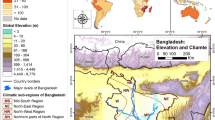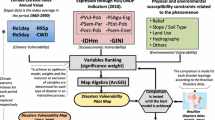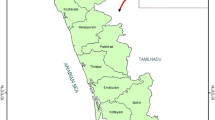Abstract
The study presents a new methodology to quantify spatiotemporal dynamics of climate change vulnerability at a regional scale adopting a new conceptual model of vulnerability as a function of climate change impacts, ecological stability, and socioeconomic stability. Spatiotemporal trends of equally weighted proxy variables for the three vulnerability components were generated to develop a composite climate change vulnerability index (CCVI) for a Mediterranean region of Turkey combining Landsat time series data, digital elevation model (DEM)-derived data, ordinary kriging, and geographical information system. Climate change impact was based on spatiotemporal trends of August land surface temperature (LST) between 1987 and 2016. Ecological stability was based on DEM, slope, aspect, and spatiotemporal trends of normalized difference vegetation index (NDVI), while socioeconomic stability was quantified as a function of spatiotemporal trends of land cover, population density, per capita gross domestic product, and illiteracy. The zones ranked on the five classes of no-to-extreme vulnerability were identified where highly and moderately vulnerable lands covered 0.02% (12 km2) and 11.8% (6374 km2) of the study region, respectively, mostly occurring in the interior central part. The adoption of this composite CCVI approach is expected to lead to spatiotemporally dynamic policy recommendations towards sustainability and tailor preventive and mitigative measures to locally specific characteristics of coupled ecological–socioeconomic systems.






Similar content being viewed by others
References
Ahsan, M. D. N., & Warner, J. (2014). The socioeconomic vulnerability index: a pragmatic approach for assessing climate change led risks: a case study in the south-western coastal Bangladesh. International Journal of Disaster Risk Reduction, 8, 32–49.
Allan, R. P., & Soden, B. J. (2008). Atmospheric warming and the amplification of precipitation extremes. Science, 321(5895), 1481–1484.
Bai, Y., Kaneko, I., Kobayashi, H., Kurihara, K., Takayabu, I., Sasaki, H., & Murata, A. (2014). A geographic information system (GIS)-based approach to adaptation to regional climate change: a case study of Okutama-machi, Tokyo, Japan. Mitigation and Adaptation Strategies for Global Change, 19, 589–614.
Barsi, J. A., Schott, J. R., Hook, S. J., Raqueno, N. G., Markham, B. L., & Radocinski, R. G. (2014). Landsat-8 thermal infrared sensor (TIRS) vicarious radiometric calibration. Remote Sensing, 6, 11607–11626.
Birkmann, J., Cardona, O. D., Carreno, M. L., Barbat, A. H., Pelling, M., Schneiderbauer, S., Kienberger, S., Keiler, M., Alexander, D., Zeil, P., & Welle, T. (2013). Framing vulnerability, risk and societal responses: the MOVE framework. Natural Hazards, 67, 193–211.
Brondizio, E. S., Vogt, N., Mansur, A., Anthrony, E., Costa, S., & Hetrick, S. (2016). A conceptual framework for analyzing deltas as coupled social ecological systems: an example from the Amazon River Delta and Estuary. Sustainability Science, 11, 591–609.
Chander, G., Markham, B. L., & Helder, D. L. (2009). Summary of current radiometric calibration coefficients for Landsat MSS, TM, ETM+, and EO-1 ALI sensors. Remote Sensing of Environment, 113, 893–903.
Coll, C., Galve, J. M., Sánchez, J. M., & Caselles, V. (2010). Validation of landsat-7/ETM+ thermal-band calibration and atmospheric correction with ground-based measurements. IEEE Transactions on Geoscience and Remote Sensing, 48, 547–555.
Demirkesen, A. C. (2008). Digital terrain analysis using Landsat-7 ETM+ imagery and SRTM DEM: a case study of Nevsehir province (Cappadocia), Turkey. International Journal of Remote Sensing, 29, 4173–4188.
Diffenbaugh, N. S., Scherer, M., & Trapp, R. J. (2013). Robust increases in severe thunderstorm environments in response to greenhouse forcing. Proceedings of the National Academy of Sciences, 110, 16361–16366.
Evrendilek, F., Karakaya, N., Aslan, G., & Ertekin, C. (2011). Using eddy covariance sensors to quantify carbon metabolism of peatlands: a case study in Turkey. Sensors, 11, 522–538.
Füssel, H.-M., & Klein, R. J. T. (2006). Climate change vulnerability assessments: an evolution of conceptual thinking. Climatic Change, 75, 301–329.
Hagenlocher, M., Lang, S., Holbling, D., Tiede, D., & Kienberger, S. (2013). Modeling hotspots of climate change in the Sahel using object-based regionalization of multidimensional gridded datasets. IEEE Journal of Selected Topics in Applied Earth Observations and Remote Sensing, 7, 229–234.
IPCC (2001). Climate change 2001: impacts, adaptation and vulnerability. Contribution of Working Group II to the Third Assessment Report of the Intergovernmental Panel on Climate Change. Cambridge: Cambridge University Press.
IPCC (2007). Assessing key vulnerabilities and the risk from climate change. Fourth Assessment Report. Cambridge: Cambridge University Press.
IPCC (2013). Climate change 2013: the physical science basis. Contribution of Working Group I to the Fifth Assessment Report of the Intergovernmental Panel on Climate Change. Cambridge: Cambridge University Press.
Liu, C., Frazier, P., & Kumar, L. (2007). Comparative assessment of the measures of thematic classification accuracy. Remote Sensing of Environment, 107, 606–616.
Liu, X., Wang, Y., Peng, J., Braimoh, A. K., & Yin, H. (2013). Assessing vulnerability to drought based on exposure, sensitivity and adaptive capacity: a case study in middle inner Mangolia of China. Chinese Geographical Science, 23, 13–25.
Murthy, C. S., Yadav, M., Ahamed, J. M., Laxman, B., Prawasi, R., Sesha Sai, M. V. R., & Hooda, R. S. (2015). A study on agricultural drought vulnerability at disaggregated level in a highly irrigated and intensely cropped state of India. Environmental Monitoring and Assessment, 187, 140.
NRC (2010). Advancing the science of climate change. National Research Council. Washington DC: The National Academies Press.
Ostrom, E. (2009). A general framework for analyzing sustainability of social–ecological systems. Science, 325, 419–422.
Rogelj, J., Meinshausen, M., & Knutti, R. (2012). Global warming under old and new scenarios using IPCC climate sensitivity range estimates. Nature Climate Change, 2, 248–253.
Rogers, S., & Xue, T. (2015). Resettlement and climate change vulnerability: evidence from rural China. Global Environmental Change, 35, 62–69.
Sebesvari, Z., Renaud, F. G., Haas, S., Tessler, Z., Kloos, J., Szabo, S., Tejedor, A., & Kuenzer, C. (2016). Vulnerability indicators for deltaic social–ecological systems: a review. Sustainability Science, 11, 1–16.
Sobrino, J. A., Jimenez-Munoz, J. C., & Paolini, L. (2004). Land surface temperature retrieval from LANDSAT TM 5. Remote Sensing of Environment, 90, 434–440.
TSI. (2015). Turkish Statistics Institute: databases. Available at: http://www.turkstat.gov.tr/. Accessed 20 Jan 2016.
TSMS. (2013). Turkish State Meteorological Service. Available at: http://mgm.gov.tr/. Accessed 20 Jan 2016.
Wali, M. K., Evrendilek, F., West, T., Watts, S., Pant, D., Gibbs, H., & McClead, B. (1999). Assessing terrestrial ecosystem sustainability: usefulness of regional carbon and nitrogen models. Nature & Resources, 35, 20–33.
Weng, Q., Lu, D., & Schubring, J. (2004). Estimation of land surface temperature-vegetation abundance relationship for urban heat island studies. Remote Sensing of Environment, 89, 467–483.
Williamson, C. E., Dodds, W., Kratz, T. K., & Palmer, M. A. (2008). Lakes and streams as sentinels of environmental change in terrestrial and atmospheric processes. Frontiers in Ecology and the Environment, 6, 247–254.
Young, B. E., Dubois, N. S., & Rowland, E. L. (2015). Using the climate change vulnerability index to inform adaptation planning: lessons, innovations, and next steps. Wildlife Society Bulletin, 39, 174–181.
Acknowledgements
We would like to thank Izmir Institute of Technology and Abant Izzet Baysal University for supporting this study. We are grateful to two anonymous reviewers for their insightful and constructive comments which significantly improved an earlier version of the manuscript.
Author information
Authors and Affiliations
Corresponding author
Rights and permissions
About this article
Cite this article
Demirkesen, A.C., Evrendilek, F. Compositing climate change vulnerability of a Mediterranean region using spatiotemporally dynamic proxies for ecological and socioeconomic impacts and stabilities. Environ Monit Assess 189, 29 (2017). https://doi.org/10.1007/s10661-016-5750-0
Received:
Accepted:
Published:
DOI: https://doi.org/10.1007/s10661-016-5750-0




